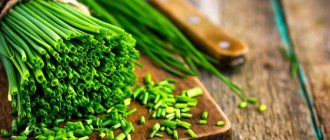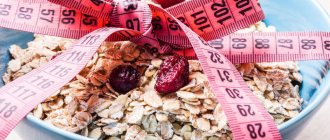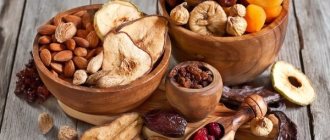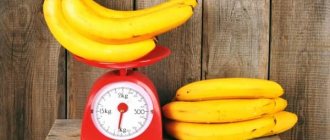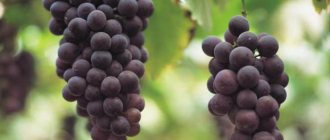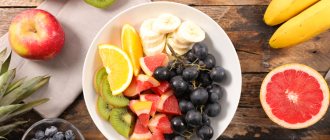How is the calorie content of fresh fruits determined?
The main calorie indicators for all existing fruits and berries can be found in the tables. As a rule, these data are averaged. The calorie content of two different apples can differ significantly.
And this will depend on the following basic characteristics:
- degree of ripeness and sweetness. The larger they are, the higher the calorie content;
- frozen fruits are lower in calories due to their high water content;
- Dried or dried fruits will be several times higher in calories than fresh ones;
- fruits with denser pulp have higher calorie content.
Important! For people who are on a diet, it is better to choose unripe fruits and vegetables, as they have a higher fiber content and lower sugar content compared to ripe ones. Ripe fruits can also work, but you need to choose the least sweet and dense ones among them.
Also, the calorie content of the fruit depends on the region of Russia or another country, the conditions in which the plant was grown, the climate, soil characteristics, fertilizers used and many other factors.
The benefits of frozen berries
However, it is precisely with flash freezing, which is used for the industrial procurement of frozen berries, that not only useful and consumer qualities are preserved. After defrosting, the berries retain the taste characteristics inherent in fresh natural material. In addition, the distinctive beneficial properties of frozen berries are preserved. The benefits of frozen berries lie in the chemical composition of the product, which, as a rule, is enriched with beneficial compounds of natural origin. In order to understand the unique benefits of frozen berries, you need to look at the chemical composition of the product.
When flash frozen, most of the beneficial compounds are retained in the frozen berries. This means that frozen berries can become not just tasty, but also healthy food products. In addition, the calorie content of frozen berries is quite low. Typically, the caloric content of frozen berries is not very different from that of fresh berries. In cooking, frozen berries are used in the same way as fresh products.
Frozen berries are used to make fillings for homemade baked goods, make desserts, make compotes, make soufflés and other confectionery products, as well as sweets. In winter, frozen berries can become not only tasty, but also a healthy treat that will appeal to all family members. For freezing, it is better to use ripe berries without visible damage.
Before freezing, the berries are carefully sorted and washed. However, it is not advisable to wash some berries (strawberries, raspberries). If you are going to store frozen berries in the general freezer of a household refrigerator, then it is better not to place the product next to the fish, since the berries will absorb the smell. Most types of berries can be frozen, with the exception of grapes, as well as red or white currants. Typically, the shelf life of frozen berries is 12 months.
Fruits with the highest calorie content
High-calorie fruits are an integral part of the diet of people trying to gain weight. They will also come in handy for children, who often have no appetite, and for teenagers as the main source of energy.
Video
The table of fruit calories per 100 grams with the highest indicator includes the following fruits:
- Avocado - about 170 calories. It is considered a very filling, high-calorie fruit, containing large amounts of potassium, fatty and monounsaturated acids. It is an alternative to fatty fish. Avocado is an oily fruit that promotes better and faster absorption of various substances in the body. Without additional processing, fresh avocados are considered the most high-calorie fruit.
- The banana in the table has about 90 calories. Contains a large amount of potassium, as well as easily digestible sugars, therefore it is considered a source of energy that promotes rapid restoration of strength. This hypoallergenic, high-calorie fruit contains tryptophan, which promotes the production of the joy hormone serotonin in the human body. Despite the high calorie content, the fruit has a moderate glycemic index;
- mango - about 70 calories in the table. This exotic, high-calorie fruit slows down the development of cancer and the aging process, acts as a powerful antioxidant, and prevents atherosclerosis. With fruit, meat will be absorbed in the body easier and faster;
- persimmon (65 calories) is a high-calorie fruit that will benefit all organs and systems. Dried persimmon helps restore strength and get rid of numbness in the limbs, but has a higher calorie content - about 250 calories. Due to the astringent effect, people with gastrointestinal problems should not get carried away with this fruit;
- Figs (55-60 calories) are another high-calorie fruit that are high in fiber, antioxidants, and vitamins. Therefore, it is recommended for people with heart disease. Figs can most often be found on sale in dried form. In this case, its calorie content increases to 180 kcal;
- papaya (about 52 calories) - contains a unique component papain, which promotes the rapid breakdown of proteins. The high-calorie fruit is equally beneficial for the body both fresh and frozen;
- pomegranate (about 50 calories) - improves blood quality, maintains health, recommended for people with anemia and thyroid diseases. The high-calorie fruit resists the growth of tumors and the spread of infections;
- nectarine (49 calories) contains a large amount of potassium, which improves the functioning of the heart and blood vessels. The fruit also contains vitamin B17, which effectively fights cancer cells. The other components included in the composition care for the skin and hair, ensure the normal functioning of the gastrointestinal tract;
- Quince (48 calories) has a strengthening effect on the heart, nerves and blood vessels. The high-calorie fruit helps remove toxins, waste and harmful substances from the body, increases appetite, and effectively treats acute respiratory infections and anemia.
Dates are considered the highest calorie product among those existing in the tables. In dried form, their energy value is 281 calories per 100 g.
Video
Useful properties of berries for weight loss
The peculiarity of the berries is that they contain practically no fat. Calories in berries come from the presence of fruit sugar. This substance belongs to carbohydrates and contains 4 kilocalories in one gram. In addition, berries contain many vitamins and microelements. Thanks to these components, the berry diet affects the metabolism in the body.
In the presence of ascorbic acid, rutin, nicotinic acid, B vitamins and carotene, adipose tissue is more easily involved in the utilization process. Many more berries contain fruit acids, which help excess fluid leave the body. As a result, a person loses several kilograms. Visible and hidden swelling disappears, which means it becomes easier for the heart to work. Vigor and ability to work return to those who follow a berry diet.
The calories in berries do not harm the body, as they carry many useful substances. Moreover, the caloric content of berries is record low.
Fruits with the lowest calorie content
There are a huge number of low-calorie fruits that can be added to various diets for weight loss.
Among them, the tables contain both familiar fruits and unusual and even exotic fruits:
- lemon (35 calories) is a storehouse of vitamin C. It is useful to consume lemons in the spring and autumn, when colds and acute respiratory infections worsen. However, one of the most low-calorie fruits has contraindications for people with gastrointestinal problems;
- grapefruit (36 calories) can have a fat-burning effect, reduce appetite, and rid the body of excess fluid. The fruit contains nutrients that normalize the functioning of the gastrointestinal tract and liver, increase the body's defenses, strengthen the walls of blood vessels, and eliminate insomnia and depression. Citrus fruits are not among the highest calorie fruits, since their energy value is below average.
- apricot (40 calories) is rich in magnesium and phosphorus, which have a beneficial effect on brain function and memory properties. The fruit also contains the component beta-carotene, which is necessary for strengthening vision, slowing down the rate of cancer development, and ensuring heart health. Dried apricot will have 6 times more calories - about 240 calories for the same 100 g;
- plum (43 calories) is very rich in vitamins B and K, as well as micro- and macroelements: magnesium, iron, calcium, potassium, phosphorus, natural acids. Plum is the best assistant in treating diseases of the genitourinary system and eliminating constipation, has a cleansing effect on the body, restores metabolic processes, and is suitable for inclusion in the diet of people on a diet;
- pear with a calorie content of 44–46 kcal is a fruit whose pulp contains a whole range of vitamins C, B1, P, and is also rich in fructose and other sugars. The seeds contain a large amount of iodine;
- Kiwi (46 to 49 calories) is a small exotic fruit rich in micro- and macroelements, vitamins and fiber. It contains much more vitamin C than citrus fruits. Fiber promotes quick satiety and protects against overeating. Therefore, kiwi is a fruit that can be included in the diet;
- apples - their calorie content is about 48 kcal depending on the variety - contain large amounts of iron, vitamin C, phosphorus and pectin. The latter substance helps cleanse the body of toxins, as well as blood and blood vessels. The valuable properties of apples are preserved even when baked;
- pineapple (48–50 kcal) contains the best existing fat burner bromelain. Eating pineapple helps normalize digestion and metabolism.
Each person’s individual table of calorie content of fruits and berries can be supplemented with oranges and tangerines with an average calorie content of 37 kcal and peaches.
Please note: There are also low-calorie fruits in the table - watermelon (23-25 calories) and melon (38-40 calories). They belong to the category of melons, are approximately 60–80% water, and help cleanse the liver and kidneys. The substance lycopene, which is part of the composition, slows down the aging process. Nutritionists recommend consuming these products during the watermelon and melon season, regardless of the type of diet chosen.
Properties of frozen berries
How much does frozen berries cost (average price per 1 kg)?
Moscow and Moscow region.
260 rub.
Summer is not only the most long-awaited warm time of the year. It is in the summer that a unique opportunity arises to replenish the reserves of vitamins and beneficial compounds that our body needs for normal functioning using natural sources. Various types of berries are available in our latitudes from spring to late autumn. Berries, along with nuts and mushrooms, have long been part of the daily diet of the Slavs. Over time, people learned to harvest berries for future use using various methods.
In the modern food industry, the most effective way to prepare berries is considered to be the method of shock or flash freezing. This technique is considered the best because it allows you to preserve in the chemical composition of frozen berries the largest amount of useful compounds that are contained in fresh berries. True, in order to quickly freeze the berries, you will need specialized equipment, namely a refrigerator. As a rule, at home, berries are frozen using the freezer of a regular refrigerator.
Calorie content of berries
The range of berries available and offered in markets and stores is very large and rich. Their average calorie content according to the tables is about 60 kcal per 100 g fresh.
The most high-calorie berries
The most high-calorie types of berries include:
- sea buckthorn - per 100 g the energy value is 81 calories; helps cleanse the body of harmful cholesterol and reduce blood pressure, restore damaged cell membranes;
- grapes - from 53 to 79 calories depending on color and type. The dark blue variety will have the highest energy value; white grapes are lighter. It is best to eat high-calorie grapes with both skin and seeds. This is a useful find for people with heart problems, as well as those with anemia and asthma;
- cherry (about 50 calories) helps remove toxins from the body, quenches thirst, but has contraindications;
- blueberries - energy value 42-44 calories. This is the best high-calorie product for humans, helping to maintain vision, helps reduce inflammatory processes in the body, and contains a huge amount of vitamin C. 100 g of blueberries contains the daily requirement of this vitamin;
- raspberries - 42 calories. Compared to other berries, raspberries contain the most manganese and zinc, are a natural antipyretic, break down fats and strengthen the walls of blood vessels.
Also among the high-calorie fruits are cherry plum, gooseberry and cherry.
Video
The lowest calorie berries
The lowest-calorie berries are presented in the table in descending order:
- blackberries - 30-35 calories. Rich in copper, zinc, minerals and vitamins, normalizes blood clotting and ensures protein synthesis;
- strawberries - 33 calories. Relieves inflammation in the body, improves vision, improves mood, is a natural antioxidant, suitable for people with heart problems;
- blueberries - 32 calories. It is also the strongest natural antioxidant, like blueberries. Lowers blood sugar levels, useful for type 2 diabetes;
- Cranberries have 27 calories. Cranberries contain nutrients that effectively fight bad cholesterol. Cranberry is an excellent medicine for infectious diseases of the genitourinary system, diarrhea, gastrointestinal problems and wounds.
This category also includes all types of currants, lingonberries, strawberries and blueberries. When fresh, the energy value of the fruits in the table does not exceed 40 calories per 100 g.
Video
Those people who have firmly decided to lose weight or gain muscle mass definitely need a table to compare the calorie content of berries and fruits. Each berry or fruit is useful in its own way. But in order for the body to feel this, it is necessary to ensure their proper use. To avoid fermentation in the stomach, you do not need to eat ripe, juicy fruits immediately after a meal. It is best to set aside time to enjoy them 30-40 minutes before meals.
Acai berries for weight loss
Acai berries are small, dark palm fruits native to northern Brazil. The fruits are rich in natural antioxidants.
Recently, it has been proposed to use acai berries for weight loss. Biologically active food supplements and the fruits themselves in their natural form are widely advertised and sold all over the world. In Russia you can also easily purchase this product.
There is no scientific evidence supporting the effectiveness of acai berries for weight loss. However, isolated cases of weight loss in acai users have been reported. Remember that these fruits are very high in calories (150 kilocalories per 100 grams). Their excessive consumption can even harm your figure. The calorie content of acai berries makes it necessary to limit their consumption to one serving per day.
Calorie table for fruits and berries
| Name of fruit | kcal | squirrels | fats | carbohydrates |
| Apricot | 41 | 0.9 | 0.1 | 10.8 |
| Avocado | 208 | 2.0 | 20.0 | 7.4 |
| Quince | 48 | 0.6 | 0.5 | 8.9 |
| Cherry plum | 27 | 0.2 | – | 6.9 |
| A pineapple | 52 | 0.3 | 0.1 | 11.8 |
| Canned pineapple | 57 | 0.1 | 0.1 | 14.0 |
| Orange | 43 | 0.9 | 0.2 | 8.4 |
| Pickled orange | 37 | 0.6 | – | 8.9 |
| Pomegranate | 52 | 0.9 | – | 13.9 |
| Grapefruit | 29 | 0.7 | 0.2 | 6.5 |
| Pear | 57 | 0.4 | 0.13 | 15.4 |
| Guava | 68 | 2.6 | 1.0 | 8.9 |
| Strawberry guava | 63 | 0.6 | 0.6 | 17.4 |
| Jackfruit | 94 | 1.4 | 0.3 | 22.4 |
| Dragon fruit | 50 | 0.5 | 0.3 | 12.0 |
| Durian | 147 | 1.5 | 5.4 | 23.4 |
| Melon | 33 | 0.6 | 0.3 | 7.4 |
| Star apple | 67 | 0.5 | 0.4 | 15.3 |
| Carambola | 31 | 1.0 | – | 7.0 |
| Kiwano | 44 | 1.8 | 1.3 | 7.6 |
| Kiwi | 47 | 0.8 | 0.4 | 8.1 |
| Clementines | 47 | 0.9 | 0.2 | 10.3 |
| Kumquat | 71 | 1.9 | 0.9 | 9.4 |
| Lime | 16 | 0.9 | 0.1 | 3,0 |
| Pickled lemon | 21 | 0.4 | 0.3 | 6.5 |
| Lemon | 34 | 0.9 | 0.1 | 3.0 |
| Lychee | 65 | 0.8 | 0.3 | 14.4 |
| Longan | 60 | 1.3 | 0.1 | 14.0 |
| Mango | 67 | 0.5 | 0.3 | 11.5 |
| Mangosteen | 62 | 0.6 | 0.3 | 14.0 |
| Mandarin | 33 | 0.8 | 0.2 | 7.5 |
| Canned mandarin | 37 | 0.6 | 0.3 | 8.9 |
| passion fruit | 68 | 2.4 | 0.4 | 13.4 |
| Marula | 48 | 0.6 | 0.5 | 9.6 |
| Medlar | 53 | – | – | 12.0 |
| Loquat japonica | 47 | 0.4 | 0.2 | 10.4 |
| Nectarine | 48 | 0.9 | 0.2 | 11.8 |
| Noina | 47 | 0.4 | 0.4 | 9.8 |
| Noni | 44 | 0.1 | 0.3 | 10.0 |
| Papaya | 48 | 0.6 | 0.1 | 9.2 |
| Peach | 46 | 0.9 | 0.1 | 11.3 |
| Canned peach | 97 | 0.5 | 0.1 | 13.7 |
| Pomelo | 32 | 0.6 | 0.2 | 6.7 |
| Rambutan | 82 | 0.6 | 0.2 | 19.0 |
| Salak | 50 | – | – | 12.0 |
| Sapodilla | 83 | 0.4 | 1.1 | 14.7 |
| Sapota | 134 | 2.1 | 0.6 | 31.2 |
| Southep | 46 | 0.5 | 0.1 | 8.0 |
| Sweetie | 58 | 0.7 | 0.2 | 9.0 |
| Plum | 42 | 0.8 | 0.3 | 9.6 |
| Tangerine | 53 | 0.8 | 0.3 | 11.5 |
| Citron | 34 | 0.9 | 0.1 | 3,0 |
| Citron Hand of Buddha | 34 | 0.9 | 0.1 | 3,0 |
| Yuzu | 21 | 0.5 | 0.1 | 7.0 |
| Apples | 47 | 0.4 | 0.4 | 9.8 |
| Fuji Apple | 71 | 0.4 | 0.2 | 19.1 |
| Banana | 95 | 1.5 | 0.2 | 21.8 |
| Watermelon | 25 | 0.6 | 0.1 | 5.8 |
| Canned watermelon | 37 | 0.5 | 0.1 | 9 |
| Barberry | 29 | – | – | 7.9 |
| Hawthorn | 52 | – | – | 14 |
| Cowberry | 43 | 0.7 | 0.5 | 9.6 |
| Soaked lingonberry | 24 | 0.3 | 0.2 | 5.3 |
| Elder | 73 | 0.7 | 0.5 | 11.4 |
| Grape | 65 | 0.6 | 0.2 | 16.8 |
| Cherry | 52 | 0.8 | 0.5 | 11.3 |
| Blueberry | 35 | 1 | – | 8.2 |
| Blackberry | 31 | 2 | – | 6.4 |
| Honeysuckle | 30 | – | – | 8 |
| Strawberries | 34 | 0.8 | 0.4 | 11.2 |
| Figs | 49 | 0.7 | 0.2 | 13.7 |
| Irga | 45 | – | – | 12 |
| Kalina | 26 | – | – | 7 |
| Strawberry | 30 | 0.6 | 0.4 | 7 |
| Cranberry | 26 | 0.5 | – | 6.8 |
| Prince | 26 | – | – | 7 |
| Gooseberry | 43 | 0.7 | 0.2 | 12 |
| Schisandra | 11 | 1 | – | 1.9 |
| Raspberries | 42 | 0.8 | 0.3 | 14.1 |
| Juniper | 116 | – | – | 31.0 |
| Cloudberry | 28 | 0.8 | – | 9.8 |
| Sea buckthorn | 52 | 0.9 | 2.5 | 10.2 |
| Rowan | 43 | 1.4 | 0.1 | 11.8 |
| White currant | 38 | 0.3 | – | 11.7 |
| Red currants | 39 | 0.6 | 0.2 | 11 |
| Black currant | 38 | 1 | 0.2 | 11.5 |
| Cherries | 50 | 1.1 | 0.4 | 11.5 |
| Blueberry | 44 | 1.1 | 0.6 | 11 |
| Chokeberry | 52 | 1.5 | 0.1 | 13.6 |
| Rose hip | 51 | 1.6 | – | 14 |
